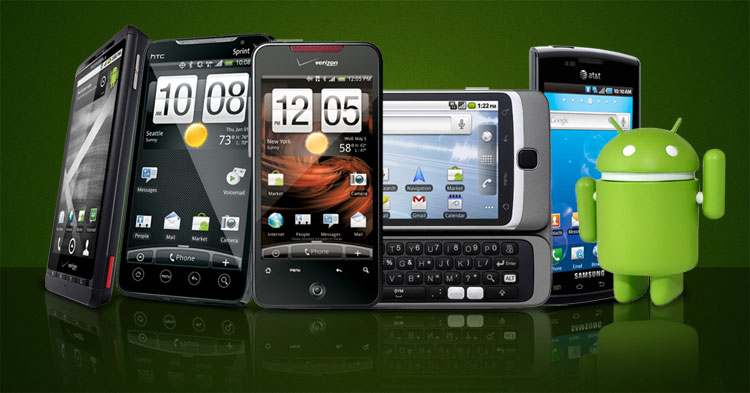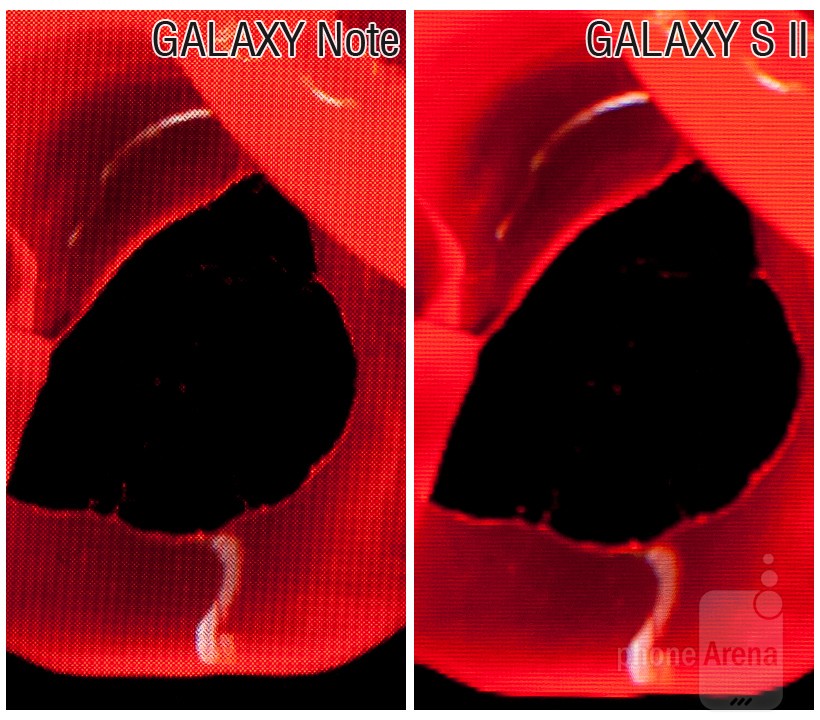The Truth About PenTile Displays

Ever since Samsung’s proprietary PenTile display arrived on the mobile scene, it has been the target of malice by nearly all major tech outlets. Its proliferation is palpable, having found its way into the majority of the Android arsenal, from the original Galaxy S and the recently released Droid Bionic and RAZR to Google’s latest flagship phone, the Samsung Nexus. But is it deserving of such universal contempt, or are its finer qualities being overlooked?
One of the biggest concerns today among smartphone users is battery life. We use our phones in an almost infinite number of ways, and we expect the battery life to keep pace. Multimedia streaming, more advanced processors, 4G phones with dual radios (to function in multiple coverage areas) and HD-resolution displays all adversely affect battery life. The display in particular has always been the greatest enemy of battery life, as power consumption increases proportionally with resolution, screen size and brightness level. Samsung anticipated this give-and-take scenario between building a smartphone with more advanced specs and reduced battery life and thus patented a subpixel matrix design called PenTile.
How PenTile Works
Diverging from the traditional RGB subpixel configuration used in nearly all digital display devices, PenTile organizes each pixel into a pair of subpixels, either RG/BW in the case of LCDs or RG/BG in the case of OLEDs. This equates to the same number of pixels as RGB panels but with 33% fewer subpixels (illustrated in the image below). As expected, this has a positive impact on power usage.
This power savings is manifested in different ways depending on which display technology it is applied to. Compared to traditional RGB designs with equivalent pixel density, RG/BW matrices in LCD displays consume less power given the same luminance level. The reasons are two-fold. In PenTile displays, the subpixels are larger in order to occupy the same screen space and thus a higher percentage of light is allowed passage (think of the difference between shining a flashlight through a fine mesh screen and a thick one). Similarly, the addition of a white (clear) subpixel dramatically increases light transmission from the backlight compared with the high absorption rate of red, green and blue subpixels. As a result, the LCD panel can be driven with less intensity to achieve a given brightness level and is regulated by the image processor’s dynamic backlight control (DBLC).
For OLED displays, PenTile works a bit differently. As OLED is an emissive display technology, each pixel is driven individually with electric current and is not dependent on a backlight. The 33% less overhead devoted to subpixels in a PenTile display clearly prolongs battery life as less voltage is required to drive each pixel, but as should be evident, a white subpixel is less helpful here. OLED PenTiles instead employ an RG/BG design. This choice was less related to battery life considerations and more to the the human visual system’s highest sensitivity to green.
Along with power savings, PenTile designs allow for increased brightness output, especially useful for outdoor viewing. Most manufacturers limit the brightness output of their devices to both preserve battery life and avoid damage to the panel. With PenTile, this is no longer a critical issue.
Quick summary: When compared to traditional RGB displays with equivalent pixel density, PenTile achieves greater power efficiency and higher luminance gains due to increased transmissivity (LCD) and reduced current draw (OLED).
Why Should We Care?
Surely the lower subpixel count has some negative impact on image quality, right? This brings us to the core disadvantage of PenTile designs, which is:
- Increased pixelation
As you will recall, PenTile displays use larger subpixels than traditional RGB displays. This has the side effect of increased pixel visibility, or the appearance that you are looking through a screen door, especially at lower ppi counts (a measure of pixel density). See the example below of the Motorola Atrix, which uses an RG/BW LCD panel.
Ppi (pixels per inch) is arguably the most salient spec of a smartphone due to the increased amount of close-proximity reading being conducted on mobile displays. Ppi count directly affects pixel visibility and is a function of both screen size and native resolution. As ppi increases, image clarity is improved (pixelation decreases). On many PenTile displays, however, ppi is insufficient to mask screen door effect and can compromise text clarity and overall sharpness.
Pixel visibility of PenTile displays also depends on which display type you are viewing as well as color saturation level. For example, the pixel structure is most visible on RG/BW LCDs when displaying saturated green, and on RG/BG OLEDs when displaying saturated red. This effect is more pronounced at higher saturation levels of those colors on their respective displays, particularly when combined with higher brightness output. While this may not be instantly noticeable at normal viewing distances, the effect is there if you look for it and is pretty obvious when compared side-by-side with a non-PenTile device.
But now as we move into the era of HD-resolution (defined as 1280×720 or greater) smartphones, such as the Samsung Nexus and HTC Rezound, this effect has diminished and even been eliminated on some displays. For the latest HD phones, screen sizes are comparable with older, lower-resolution screens. This means ppi will increase accordingly.
Let’s take a look at a few examples:
1. The Droid RAZR, Droid Bionic, Droid X2 and Motorola Atrix are RG/BW LCD PenTile displays.
RAZR, Bionic, X2: 4.3″ @ 960×540 = 256 ppi
Atrix: 4.0″ @ 960×540 = 275 ppi
2. The OG Galaxy S and the new Galaxy Nexus are RG/BG OLED PenTile displays.
Galaxy S: 4.0″ @ 800×480 = 233 ppi
Galaxy Nexus: 4.65″ @ 1280×720 = 316 ppi
There is a point at which ppi increases beyond the limits of human visual acuity. The latest Android phones have, for the most part, hit that ceiling. The Nexus uses the latest Super AMOLED Plus PenTile screen, running at native 720p and a ppi count of 316. This should appreciably reduce pixel visibility relative to its predecessors. Only those with the sharpest visual acuity or those resorting to magnification will likely have anything to complain about in the way of pixelation on these latest PenTile devices. The thing to remember is a higher ppi count will always result in greater image and textual clarity. Thus, quality can vary substantially among PenTile displays.
Is Color Quality Affected?
Many tech journalists have also stated that since fewer subpixels contribute to image reconstruction on PenTile displays, color is less accurately reproduced. While this might seem intuitively correct, it doesn’t hold much currency under close scrutiny. This is because PenTile displays do not work like standard RGB displays. RGB displays render images at the pixel level, where unique luminance and chrominance information assigned to each of the R-G-B components is isolated to a single pixel. Conversely, images on a PenTile display are subpixel rendered, where subpixels are not restricted to a single pixel in the traditional sense, but can participate in multiple logical pixels within close proximity. This is accomplished via proprietary subpixel rendering (SPR) and adaptive filtering algorithms native to the image processor. So it is actually the case that with PenTile displays, the number of points that may be independently addressed to reconstruct the image is increased rather than decreased. The zoomed image below compares the RG/BG Galaxy Note and the traditional RGB Samsung Galaxy S II. Apart from visible pixel structure, color characteristics appear identical.
As noted above, the quality of the image produced by a PenTile display almost singularly depends on the image processor fitted to the phone and its underlying algorithms. If there is a bug present in the processor, or if the gamut mappings (RGB to RGBW, for example) are inaccurate, then color aberrations may result. We’ve seen this with the Droid X2. Unfortunately, if color errors are present, they can only be rectified via compensating picture controls. The Galaxy S II included some for the Euro market, but few, if any, U.S. smartphones include these controls. According to Nouvoyance (PenTile’s developer), PenTile displays provide for color and power controls, but it is apparently up to the phone manufacturer whether or not to include them as many PenTile phones do not.
One last point on color reproduction relates to the inherent characteristics of OLED displays. OLED pixels are composed of carbon-based molecules, and each color molecule has a different aging rate. Blue-colored OLEDs lose luminosity faster than do red and green OLEDs, which can result in a dimming effect over time. Smartphone manufacturers attempt to compensate for this by setting the white point higher for OLED screens than on most standard colorimetry models, which causes white areas to appear slightly more blue than is standard. Again, this is tied to OLED technology itself and should not be attributed to PenTile design.
As you can see, there is slightly more to Samsung’s PenTile than the tech sites’ predominant conclusion to “avoid them at all costs.” As phones reach higher and higher resolutions, pixel structure shrinks to negligible levels and PenTile becomes indistinguishable from standard RGB displays. Even though personal visual acuity varies significantly from user to user, the new Samsung Nexus should appear every bit as sharp as non-PenTile phones and, in fact, this issue should not even factor into your purchasing decision. The very measurable impact on battery life that PenTile provides heavily outweighs any of its drawbacks.
Comment if you have a PenTile phone and whether you have noticed any pixel abnormalities. Will you buy the Nexus? Was this post overkill? Does screen quality even matter to you? Sound off.
Sources:





Comments